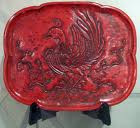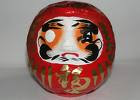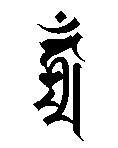:::::::::::::::::::::::::::::::::::::::::::::::::::::::::::::::::::::::::::::::::::::::::::::::::::::::::::::::::::::::::::
Kamakurabori - Daruma and Laquerware
鎌倉彫り


Carved laquer objects made in Kamakura
First some general remarks about laquer techniques.
Laquerware is created from the sap of the laquer tree for practical and artistic equipment we use in our daily lives. The advantage of laquer is its strong natural adhesive property and it is very easily processed into pieces. Traditionally many coatings of laquer are applied and after drying patterns are carved out of the laquer. With Kamakurabori the process is the opposite. First the wood is carved and then only a few coatings are used to cover it. In this way the normally expensive laquer pieces could be produced at a more affordable level for every-day use objects.

The coating with laquer not only helps create beautiful pieces, but it also has the following advantages:
1. Preserves products from decomposition.
2. Keeps beautiful sheen and luster forever.
3. Provides soft and warm feeling when touched. This is important when you
use laquerware for eating tools.
4. Anti-acidity, anti-alkaline and anti-electric properties and a great
endurance against wear and tear.
5. The coating can be applied to almost anything, wood, iron, paper, leather.
6. It is easy to add other decorations after laquer coating.
Here are some forms of decoration:
Pictures painted or inlayed in laquer 漆絵(Urushi-e)
Pictures with sprincled powder of gold, silver or other materials 薪絵(Maki-e)
Gold or silver inlay in scratch marks of urushi 沈金(Chinkin)沈銀(Chingin)
Inlay of shells 螺鈿(Raden)

from the Fenolossa Cyber Museum.
Kamakurabori
is a specialty of the city of Kamakura. It's a combination of woodcarving and lacquer-work. Designs are carved in wood and then coated many times with red and black lacquer. The carving technique dates from the 13th century and originates from Buddhist statue sculptors. Their technique was succeeded from one generation to another. The present owner of the store Hakkoodoo in Kamakura for example is the 28th direct descendant of the founder of the Goto Buddhist-statue sculptor family.
As Kamakura began to wane in importance in the 15th century, demand for statue carving dropped. The artists found a niche in the area of utensils such as trays used domestically in the kitchen, and today, Kamakurabori is a special product of the city.
:::::::::::::::::::::::::::::::::::::::::::::::::::::::::::::::::::::::::::::::::::::::::::::::::::::

Kamakura-bori ... further reference
:::::::::::::::::::::::::::::::::::::::::::::::::::::::::::::::::::::::::::::::::::::::::::::::::::::
Walking in Kamakura 鎌倉散歩
Since Kamakura is easily reached by Yokosuka Line from Tokyo it is a good place for a daytrip. I lived in Kamakura for more than 15 years before moving to Okayama prefecture, so I will introduce you to some of my favorite spots.
First the "Coin-Washing" Zeniarai Benten 銭洗弁天. zeniarai Benten
According to legend, the Shrine dates from the era of Yoritomo Minamoto (1147-1199), the founder of the Kamakura Shogunate. One night after a series of battles, an old man appeared in his dream and said, "I am the god of Ugajin. There is a spring in the gorge located in the northwest direction of Kamakura. Go find it and worship Ugajin with the spring water. People may start to have faith in the god and peace will be restored." It was the day of the Serpent, the month of the Serpent in 1185, the year of Serpent on lunar calendar based on twelve zodiac signs.
. . . CLICK here for Photos !
Believe me, I have washed a lot of coins there and it seems to have helped a little!
Inari 稲荷 <> The Fox God Cult Kitsune, the animal fox.
One of my favorites is the temple Kakuon-ji, 覚園寺 hidden in the back of a valley and coming to live every year at August 10 for the midnight festival of the Black Jizo Bosatsu (kurojizoo 黒地蔵).
August 10 every year is the day to venerate this Black Jizo Bosatsu. A religious service for him starts at twelve midnight with gongs and bells, attended by a number of Shingon sect priests chanting Han'nya shingyoo, or Prajna-paramita sutra.
. . . CLICK here for Photos !
If you find time it is well worth a visit. From the big statue of Yakushi Nyorai in the Main Hall there is a long five-colored cord through the hall and outside in the garden, where it is hanging from a large pole, so you can get in direct TOUCH with this Healing Buddha. The hall is lit by candles and all seems far removed from time and space. Visitig the Cave with 13 Buddhas you get almost choked by the smoke of so many candles and have a real foretaste of hell.
There are not many chances these days to "experience" a Buddha statue in its original setting made for veneration and lit by candles. To spend a long mysterious summer night here in these otherwise quiet temple grounds shows you a glimpse of OLD KAMAKURA, better than the fireworks at the sea two days later.
KAMAKURA ... further reference
:::::::::::::::::::::::::::::::::::::::::::::::::::::::::::::::::::::::::::::::::::::::::::::::::::::
Daruma of Kamakurabori

Here is a Bolotie holder of my collection. It is only 3.5 cm large. I bought it many years ago and it was quite expensive already then.
これは達磨さんがボーロネクタイ・ホールダになる作品です。

Next we have a small netsuke of 4.5 cm.
This Daruma looks almost like the Daibutsu, the Big Buddha of Kamakura. From his painstakenly carved eyebrows you can see it is Daruma san.

And finally one more piece of laquer, but this may be Negoro laquer.
This one is very special. It is a box where you put your cloths after undressing in the evening or for the daily bath (midarekago). I can well imagine the headpriest of some Kamakura temple having this made to order and use it daily to remind himself of the spirit of Zen in daily life. This box is 70 cm long and 48 cm wide. Inside is a carving of Daruma standing on a rush leaf (royoo Daruma).
Rush-Leaf Daruma (royoo) 芦葉達磨 Daruma on a reed
. My PHOTO ALBUM - Laquer Daruma Figures
Urushi no ki 漆 うるし <> Lacquer Tree
:::::::::::::::::::::::::::::::::::::::::::::::::::::::::::::::::::::::::::::::::::::::::::::::::::::::::::::::::::::::::::
... Kamakura, my Haiku Town in Japan
::::::::::::::::::::::::::::::::::::::::::::::::::::::::::::::::::::::::::::::::::::::::::::::::::::::::::::::::::::::::::::::::::::::::::::::::::::::::::::::::::::::::::::::::::::::::::::::::::::::::::::::::::::::::::::::::::::::::::::::::::::::
looptie ループタイ looptie holder, bolo tie

bolotie holder

pink coral ピンク珊瑚
ruupu tai ループタイ bolo tie, looptie

- source : rakuten.co.jp/sangoya
:::::::::::::::::::::::::::::::::::::::::::::::::::::::::::::::::::::::::::::::::::::::::::::::::::::::::::::::::::::::::::
. Fudō Myō-ō, Fudoo Myoo-Oo 不動明王 Fudo Myo-O
Acala Vidyârâja - Vidyaraja - Fudo Myoo .
loop tie ループタイ Fudo Myo-O

source : rakuten.co.jp/horigin
:::::::::::::::::::::::::::::::::::::::::::::::::::::::::::::::::::::::::::::::::::::::::::::::::::::::::::::::::::::::::::
[ . BACK to DARUMA MUSEUM TOP . ]
[ . BACK to WORLDKIGO . TOP . ]
:::::::::::::::::::::::::::::::::::::::::::::::::::::::::::::::::::::::::::::::::::::::::::::::::::::::::::::::::::::::::::















































